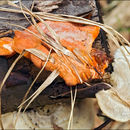Associations
provided by BioImages, the virtual fieldguide, UK
Foodplant / saprobe
fruitbody of Pycnoporus cinnabarinus is saprobic on dead wood of Broadleaved trees
In Great Britain and/or Ireland:
Foodplant / saprobe
fruitbody of Pycnoporus cinnabarinus is saprobic on dead wood of Betula
Comprehensive Description
provided by North American Flora
Pycnoporus cinnabarinus (Jacq.) Karst. Rev. Myc. 3*: 18. 1891
Boletus cinnabarinus Jacq. Fl. Austr. 4 : 2. 1776. Boletus coccineus^vX.. Herb. Fr. 364. 1791. Polyporus cinnabarinus Fries, Syst. Myc. 1 : 371. 1821. Trametes cinnabarina^ri^Q, Nov. Synib. 98. 1851.
4
Pileus convex-plane, dimidiate, laterally extended, reviving the second season, 4-6 X
5-10X0.5-1 cm.; surface azonate, rugulose, pruinose to tomentose, at length glabrous,
the color changing from light-orange to cinnabar-red, often fading with age ; margin acute,
except in large plants, faintly zonate : context floccose, elastic, zonate, reddish ; tubes
nearly equaling the context, firm, miniatous within, the mouths small, 2-3 to a mm.,
regular, coccineous, dissepiments rather thin, entire: spores smooth, hyaline, 6-8X2-3/^.
Type locality : Carinthia, Austria. Habitat : Dead wood of various deciduous trees.
Distribution : Canada and the United States ; also in Burope and Asia.
- bibliographic citation
- William Alphonso MurrilI, Gertrude Simmons BurIingham, Leigh H Pennington, John Hendly Barnhart. 1907-1916. (AGARICALES); POLYPORACEAE-AGARICACEAE. North American flora. vol 9. New York Botanical Garden, New York, NY
Pycnoporus cinnabarinus: Brief Summary
provided by wikipedia EN
Pycnoporus cinnabarinus, also known as the cinnabar polypore, is a saprophytic, white-rot decomposer. Its fruit body is a bright orange shelf fungus. It is common in many areas and is widely distributed throughout the world. It is inedible. It produces cinnabarinic acid to protect itself from bacteria.
The stipe and the pore surface had a positive reaction with potassium hydroxide.
- license
- cc-by-sa-3.0
- copyright
- Wikipedia authors and editors

